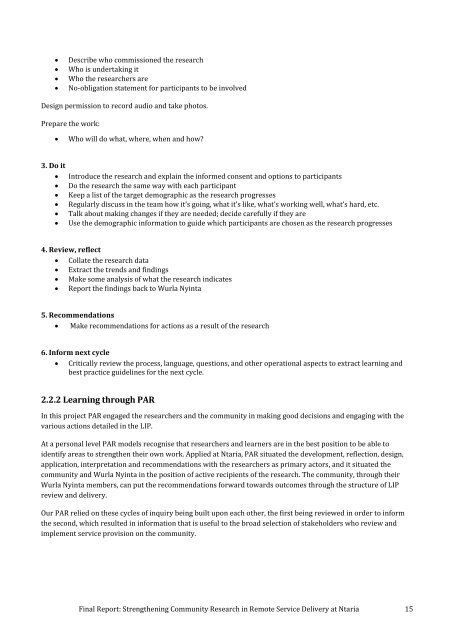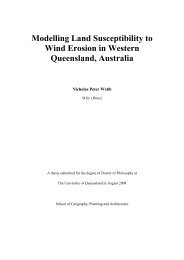Final Report: Strengthening Community Research in ... - Ninti One
Final Report: Strengthening Community Research in ... - Ninti One
Final Report: Strengthening Community Research in ... - Ninti One
You also want an ePaper? Increase the reach of your titles
YUMPU automatically turns print PDFs into web optimized ePapers that Google loves.
Describe who commissioned the researchWho is undertak<strong>in</strong>g itWho the researchers areNo-obligation statement for participants to be <strong>in</strong>volvedDesign permission to record audio and take photos.Prepare the work:Who will do what, where, when and how?3. Do it Introduce the research and expla<strong>in</strong> the <strong>in</strong>formed consent and options to participants Do the research the same way with each participant Keep a list of the target demographic as the research progresses Regularly discuss <strong>in</strong> the team how it’s go<strong>in</strong>g, what it’s like, what’s work<strong>in</strong>g well, what’s hard, etc. Talk about mak<strong>in</strong>g changes if they are needed; decide carefully if they are Use the demographic <strong>in</strong>formation to guide which participants are chosen as the research progresses4. Review, reflect Collate the research data Extract the trends and f<strong>in</strong>d<strong>in</strong>gs Make some analysis of what the research <strong>in</strong>dicates <strong>Report</strong> the f<strong>in</strong>d<strong>in</strong>gs back to Wurla Ny<strong>in</strong>ta5. Recommendations Make recommendations for actions as a result of the research6. Inform next cycle Critically review the process, language, questions, and other operational aspects to extract learn<strong>in</strong>g andbest practice guidel<strong>in</strong>es for the next cycle.2.2.2 Learn<strong>in</strong>g through PARIn this project PAR engaged the researchers and the community <strong>in</strong> mak<strong>in</strong>g good decisions and engag<strong>in</strong>g with thevarious actions detailed <strong>in</strong> the LIP.At a personal level PAR models recognise that researchers and learners are <strong>in</strong> the best position to be able toidentify areas to strengthen their own work. Applied at Ntaria, PAR situated the development, reflection, design,application, <strong>in</strong>terpretation and recommendations with the researchers as primary actors, and it situated thecommunity and Wurla Ny<strong>in</strong>ta <strong>in</strong> the position of active recipients of the research. The community, through theirWurla Ny<strong>in</strong>ta members, can put the recommendations forward towards outcomes through the structure of LIPreview and delivery.Our PAR relied on these cycles of <strong>in</strong>quiry be<strong>in</strong>g built upon each other, the first be<strong>in</strong>g reviewed <strong>in</strong> order to <strong>in</strong>formthe second, which resulted <strong>in</strong> <strong>in</strong>formation that is useful to the broad selection of stakeholders who review andimplement service provision on the community.<strong>F<strong>in</strong>al</strong> <strong>Report</strong>: <strong>Strengthen<strong>in</strong>g</strong> <strong>Community</strong> <strong>Research</strong> <strong>in</strong> Remote Service Delivery at Ntaria 15
















